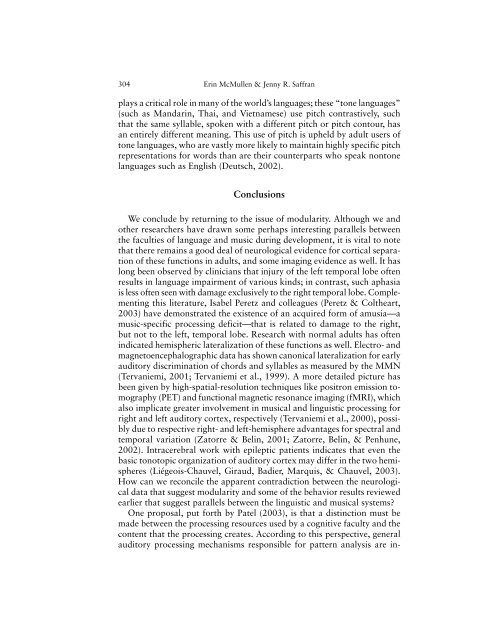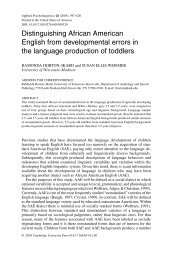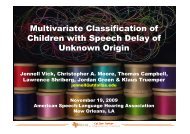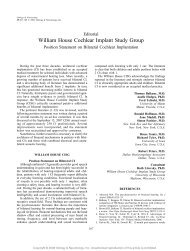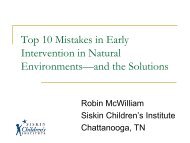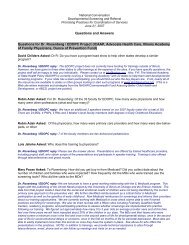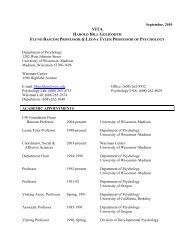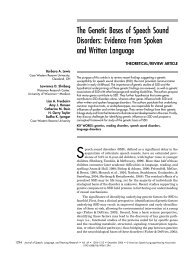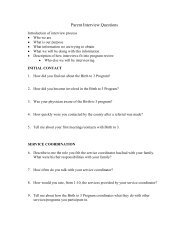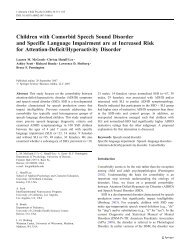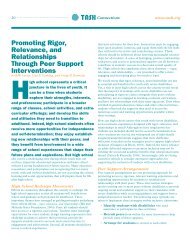Music and Language: A Developmental Comparison - Waisman ...
Music and Language: A Developmental Comparison - Waisman ...
Music and Language: A Developmental Comparison - Waisman ...
You also want an ePaper? Increase the reach of your titles
YUMPU automatically turns print PDFs into web optimized ePapers that Google loves.
304 Erin McMullen & Jenny R. Saffranplays a critical role in many of the world’s languages; these “tone languages”(such as M<strong>and</strong>arin, Thai, <strong>and</strong> Vietnamese) use pitch contrastively, suchthat the same syllable, spoken with a different pitch or pitch contour, hasan entirely different meaning. This use of pitch is upheld by adult users oftone languages, who are vastly more likely to maintain highly specific pitchrepresentations for words than are their counterparts who speak nontonelanguages such as English (Deutsch, 2002).ConclusionsWe conclude by returning to the issue of modularity. Although we <strong>and</strong>other researchers have drawn some perhaps interesting parallels betweenthe faculties of language <strong>and</strong> music during development, it is vital to notethat there remains a good deal of neurological evidence for cortical separationof these functions in adults, <strong>and</strong> some imaging evidence as well. It haslong been observed by clinicians that injury of the left temporal lobe oftenresults in language impairment of various kinds; in contrast, such aphasiais less often seen with damage exclusively to the right temporal lobe. Complementingthis literature, Isabel Peretz <strong>and</strong> colleagues (Peretz & Coltheart,2003) have demonstrated the existence of an acquired form of amusia—amusic-specific processing deficit—that is related to damage to the right,but not to the left, temporal lobe. Research with normal adults has oftenindicated hemispheric lateralization of these functions as well. Electro- <strong>and</strong>magnetoencephalographic data has shown canonical lateralization for earlyauditory discrimination of chords <strong>and</strong> syllables as measured by the MMN(Tervaniemi, 2001; Tervaniemi et al., 1999). A more detailed picture hasbeen given by high-spatial-resolution techniques like positron emission tomography(PET) <strong>and</strong> functional magnetic resonance imaging (fMRI), whichalso implicate greater involvement in musical <strong>and</strong> linguistic processing forright <strong>and</strong> left auditory cortex, respectively (Tervaniemi et al., 2000), possiblydue to respective right- <strong>and</strong> left-hemisphere advantages for spectral <strong>and</strong>temporal variation (Zatorre & Belin, 2001; Zatorre, Belin, & Penhune,2002). Intracerebral work with epileptic patients indicates that even thebasic tonotopic organization of auditory cortex may differ in the two hemispheres(Liégeois-Chauvel, Giraud, Badier, Marquis, & Chauvel, 2003).How can we reconcile the apparent contradiction between the neurologicaldata that suggest modularity <strong>and</strong> some of the behavior results reviewedearlier that suggest parallels between the linguistic <strong>and</strong> musical systems?One proposal, put forth by Patel (2003), is that a distinction must bemade between the processing resources used by a cognitive faculty <strong>and</strong> thecontent that the processing creates. According to this perspective, generalauditory processing mechanisms responsible for pattern analysis are in-


